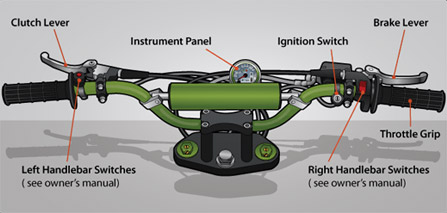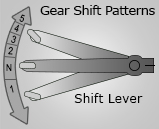How to Ride a Motorcycle
Learning how to ride a motorcycle is exciting. We recommend to find and enroll in your local MSF (Motorcycle Saftey Foundation) course. Take the 1 day or 3 day basic rider MSF course to learn how to ride and earn your motorcycle license. If you dont want to or can't take a MSF course, learn in the safest spot you can, like big emtpy parking lot. But its highly recommended to take the MSF course to learn hands on with proper coaching.
Familiarize yourself with the diagrams/ images
Step 1:
Put some safety gear on.
• Helmet
• Gloves
• Some kind of long sleeve jacket (something breathable on warmer days)
• Jeans (most common)
• Ankle protective shoes (tuck laces under the tongue so they don’t get caught on anything).
Step 2:
Swing your leg over the bike and plant both feet on the ground. Make sure to always get on and off the bike from the left to avoid the exhaust.
Step 3:
Get comfortable with the bike: adjust mirrors, get a feel for the foot pegs, and check for the turn signal location, horn, and lights. And familiarize yourself with throttle, brake, clutch and shift pedal.
Keep in mind the right side is for acceleration and braking, and the left side is for controlling gears.
Step 4: Pull in the front brake and pull the motorcycle off of the kickstand. Then find natural, pull the clutch in and push down on the gear shifter repeatedly until its in first (can no longer be pressed down). Slowly press up on the gear shifter a half a click (neutrals between 1st and 2nd). And a green light should appear on the gauge cluster. And release the clutch
Step 5:
Flip the kill-switch to the on position (symbol with a small cutout of a circle). Make sure you have the kickstand kicked up with your left foot. Then press and hold the ignition switch until the bike starts. (if you have a carbureted motorcycle, you may need to adjust the coke a bit and give it some gas when starting the bike)
Step 6:
Downshift the bike back into first but hold in the clutch. Let go of the brake, don’t give the motorcycle any gas and very gently let the clutch out until you feel it starting to grab and pulling the bike forward and pull the clutch back in and pull the front brake back in. That is the friction zone, the point of which the gears begin connecting to rotate the rear wheel. Repeat this step until you’re comfortable with where the friction zone is.
Step 7:
Once comfortable with the friction zone, begin doing the same as step 6, but till you let the clutch all the way out (keep it slow and steady still). While the gears are grabbing more and more, it’ll pick up more speed, so you’ll need to gently walk the bike with your feet for a few steps to help stay balanced. Once the clutch is all the way out, you should be able to put your feet up on the pegs. Once rolling for a bit, pull the clutch back in and gently pull on the front brake. Repeat about 5-10 times, and then you can start adding a little bit of gas when in the friction zone and after the clutch is all the way out. But stay 10-15mph.
(If you run out of room, either stop and put it in neutral and walk it around, or stick your feet out just in case and turn the handlebars slightly.)
Step 8:
Once you’ve practiced Step 7 plenty of times till your comfortable with the clutch, throttle and brake. Repeat Step 7 and get the bike to 8-12 mph, but don’t stop; practice turning. Whichever way you want to turn, look at it, then turn the handlebars. But don’t hit front brake when the handlebars aren’t straight. You could have the potential of dumping the bike easily. So if you need to slow down, just very gently ride the rear brake
Ex: Want to turn right; looks and find where to go, stay focused on it, and pull the handlebar with your right hand and/or push with left hand gently till you’re about looking straight where you want to go, start straightening the handlebars.
Ride around making a big figure eight and/or weaving back and forth, to till you comfortable and confident to go further.
Step 9:
Now start going 15-20mph and practice Counter Steering and leaning. Counter Steering can be hard to understand for some people, but it’s only natural. Counter Steering is when you steer the handlebars in the opposite direction then where you want to go. Because when going 15-20mph or faster, if you turn the handlebars one way, it’ll begin leaning over. Thus turn the motorcycle in the opposite direction as the handlebars. So slowly start picking up the pace and make bigger turns.
Step 10:
Now that you can control the motorcycle at slower speeds, it’s time to learn how to upshift gears to be able to go faster. Below is a guestimate of when to shift:
0-15 MPH - 1st
15 - 30 MPH - 2nd
30 - 45 MPH - 3rd
45 - 55 MPH - 4th
55 - 65 MPH - 5th
65+ MPH - 6th
Once you’re going fast enough to upshift to another gear, you’ll want to roll off the throttle and pull the clutch in. Then kick the gear lever up, and roll back on the throttle as you let the clutch back out.
Step 11:
And downshifting has only 2 differences to up shifting. You need to kick the gear lever down and give it more throttle when letting the clutch out; for the lower gear to match the higher rev’s.
Additional Note:
When at speed and are braking, be careful of how much you use the rear brake. Under hard braking, the front tire will do the most work because all the weight will transfer forward, thus making the rear wheel light and easier to lock up and slide. And keep in mind, the bike will go where you want it to go. So be careful of Target Fixation during a turn, keep looking where you want to go. Don’t get distracted and look elsewhere. Because you can end up not going where you intended.
Now put your gear on, get out there, be safe and use your head.


